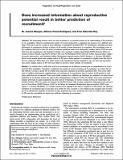Please use this identifier to cite or link to this item:
http://hdl.handle.net/10261/44966Share/Export:
 SHARE SHARE
 CORE
BASE CORE
BASE
|
|
| Visualizar otros formatos: MARC | Dublin Core | RDF | ORE | MODS | METS | DIDL | DATACITE | |

| Title: | Does increased information about reproductive potential result in better prediction of recruitment? |
Authors: | Morgan, M. Joanne; Pérez-Rodríguez, Alfonso CSIC; Saborido-Rey, Fran CSIC ORCID | Keywords: | Reproductive potential Recruitment |
Issue Date: | 19-Jul-2011 | Publisher: | National Research Council Canada | Citation: | Canadian Journal of Fisheries and Aquatic Sciences 68(8): 1361-1368 (2011) | Abstract: | The relationship between stock size and recruitment is an essential element in the understanding of the productivity
of a population. However, predicting the number of recruits produced by a population has proven to be a difficult challenge.
This may in part be a result of poor estimation of reproductive potential (RP). We determined if including increased
information on reproductive biology in indices of RP results in better predictions of recruitment. We investigated some of
the conditions that lead to better (or worse) recruitment prediction when more biologically complex indices of RP are used.
Data from four populations in the Northwest Atlantic were examined: southern Grand Bank (NAFO Division 3NO) cod
(Gadus morhua), Flemish Cap (NAFO Division 3M) cod, Newfoundland (NAFO Division 3LNO) American plaice (Hippoglossoides
platessoides), and Greenland halibut (Reinhardtius hippoglossoides) (NAFO Subarea 2 + Division 3KLMNO).
Stock–recruit models paired with complex indices of RP gave a better estimate of recruitment in slightly more than half of
the tests conducted. When there were larger trends in the reproductive biology (maturity at age, sex ratio and egg production),
more complex indices of RP were more likely to provide a better estimate of recruitment. The relationship between stock size and recruitment is an essential element in the understanding of the productivity of a population. However, predicting the number of recruits produced by a population has proven to be a difficult challenge. This may in part be a result of poor estimation of reproductive potential (RP). We determined if including increased information on reproductive biology in indices of RP results in better predictions of recruitment. We investigated some of the conditions that lead to better (or worse) recruitment prediction when more biologically complex indices of RP are used. Data from four populations in the Northwest Atlantic were examined: southern Grand Bank (NAFO Division 3NO) cod (Gadus morhua), Flemish Cap (NAFO Division 3M) cod, Newfoundland (NAFO Division 3LNO) American plaice (Hippoglossoides platessoides), and Greenland halibut (Reinhardtius hippoglossoides) (NAFO Subarea 2 + Division 3KLMNO). Stock–recruit models paired with complex indices of RP gave a better estimate of recruitment in slightly more than half of the tests conducted. When there were larger trends in the reproductive biology (maturity at age, sex ratio and egg production), more complex indices of RP were more likely to provide a better estimate of recruitment. |
Publisher version (URL): | http://dx.doi.org/10.1139/F2011-049 | URI: | http://hdl.handle.net/10261/44966 | DOI: | 10.1139/F2011-049 | E-ISSN: | 0706-652X |
| Appears in Collections: | (IIM) Artículos |
Files in This Item:
| File | Description | Size | Format | |
|---|---|---|---|---|
| Morgan.pdf | 203,63 kB | Adobe PDF |  View/Open |
CORE Recommender
WEB OF SCIENCETM
Citations
42
checked on Feb 28, 2024
Page view(s)
365
checked on Apr 18, 2024
Download(s)
402
checked on Apr 18, 2024
Google ScholarTM
Check
Altmetric
Altmetric
WARNING: Items in Digital.CSIC are protected by copyright, with all rights reserved, unless otherwise indicated.
